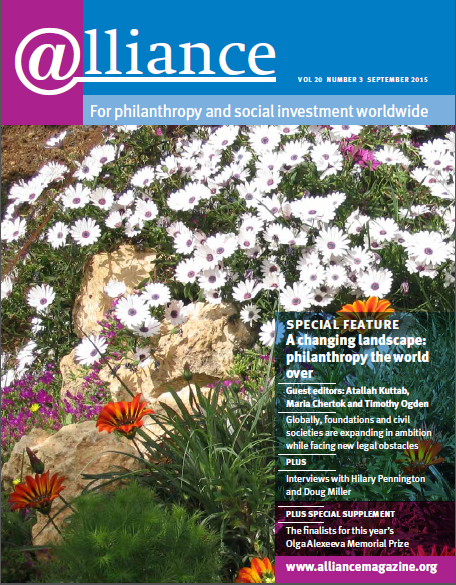It’s widely assumed that donors are more focused on impact and effectiveness than they used to be when making decisions about giving. Just from listening to the language of philanthropy – the increasing references to strategic philanthropy, impact measurement and return on investment, the growing use of the term ‘investor’ instead of ‘donor’ – you might draw the conclusion that impact now rules with donors. But is this really the case? Is the rational, impact-driven philanthropist more a creature of legend than fact? Alliance talked to a number of people who work with donors and asked them what they think.
So is donor behaviour changing? Caroline Fiennes of Giving Evidence doubts it. ‘Nobody actually has a good dataset from which we could reliably see this change. We all have loads of anecdotes about donors, but no way of knowing if they are representative. There are few studies of how donors actually behave with respect to evidence.’
One of the very few donor surveys is New Philanthropy Capital’s 2013 Money For Good UK, but even here she notes a major problem: ‘it asked people to report what they do when choosing a charity. The answers people give to such questions are known to often be completely different to what they actually do. This may have been the problem with the inaccuracy of opinion polls before the recent UK general election. As Rory Sutherland of Ogilvy wrote, “[the] parts of the brain that talk aren’t the same as the parts of the brain which decide”.’
By contrast, ‘the indisputable rise in interest in rigorous evaluators, eg GiveWell, The Life You Can Save, and membership of Giving What We Can’ does provide some evidence to suggest that donor behaviour is changing.
Tris Lumley of NPC in the UK also notes that ‘we just don’t have longitudinal data’. From his own experience, NPC donors are ‘definitely more focused on impact’. NPC’s work with them includes ‘helping them to develop their own theories of change, a prerequisite for being able to plan, manage, assess and learn from the impact of their philanthropy. Five years ago, this wasn’t the case’. However, he concedes it is ‘not yet so clear whether this interest is really translating into an actual focus on impact in their approaches, decision-making and ultimately where their money goes’. Even where they see a change of attitude, most agree that practice is falling short of the rhetoric.
Andreas Rickert of PHINEO in Germany similarly sees some good examples. Siemens, for instance, has implemented corporate citizenship projects applying venture philanthropy principles. But he does not see an appropriate implementation at a large scale across what he calls the entire landscape of philanthropy.
A growing interest in impact measurement
What is undeniable is that there is a growing interest in impact measurement. Rickert sees this as the most obvious indicator of donors’ changing motivations. He talks of a ‘paradigm shift: from input orientation towards impact orientation’. In Germany, he cites the increased media attention that impact is receiving – ‘the leading news portal Spiegel Online had a top story about transparency and impact of the social sector’ – and the fact that the best attended session at the last conference of the Association of German Foundations was the one on impact. Farrukh Khan of Acumen believes ‘there is definitely an increasing interest from donors in understanding effectiveness and impact’.
‘Research in the UK in 2013 showed that 75 per cent of UK NGOs measure some or all of their work and that nearly two-thirds had invested more in impact measurement over the past five years.’
Luis Fernandez of CAF also notes an increased interest in impact measurement globally. He cites South African research showing that 60 per cent of civil society organizations are interested in impact measurement, with 80 per cent of them ‘willing to spend resources on impact measurement’. In the US, too, he says, there is ‘a very high level of interest in impact measurement (60 per cent of organizations in the philanthropic sector)’. In India, the increased donor interest in quantitative metrics has, in turn, increased ‘the number of NGOs producing impact reporting to attract more funds’. Research in the UK in 2013 showed that 75 per cent of UK NGOs measure some or all of their work and that nearly two-thirds had invested more in impact measurement over the past five years. Significantly for the purposes of this article, ‘the motivations for investment have been mostly funding-driven’.
He also advances what he sees as a major reason for why this is happening: the rise of a new generation of philanthropists ‘seeking to define how philanthropy is making a difference in solving fundamental social problems. This difference can no longer be explained by performance or purely financial indicators … so impact measurement is critical to understanding what works – and what works best’.

Caroline Fiennes: ‘It is easier to look up the effectiveness of some surgical intervention than to find out if Christian Aid is any good.’
Barriers to changing donor behaviour
Despite the interest in impact measurement, our respondents remain sceptical about whether donor behaviour is changing, whether they are really more swayed by evidence of effectiveness and impact when it comes to choices about giving. So why isn’t donor behaviour changing?
Lack of awareness that the choice matters
Caroline Fiennes sees two issues to tackle: first, ‘awareness that the choice matters, that some charities are better than others, that some causes are more important/urgent than others, that some interventions are more cost-effective than others. Second, the humungous difficulty currently of actually finding out which are the good ones’. For instance, she says: ‘If you want to look up the effectiveness of some surgical intervention, I can tell you exactly where to look despite not working in health. But if you want to know if Christian Aid is any good, even I, as a professional philanthro-nik, have basically no clue where you should look.’
Fear of being blamed for lack of impact
Andreas Rickert believes that the major barrier to change is ‘fear on two levels: fear of being blamed for not having achieved the maximum impact, and fear of being overwhelmed by higher overhead costs and complex methods’. Donors, he argues, think it’s safer to stick with input measures: if you look at what you’ve achieved with evaluations and impact assessments, you draw attention to your failures and shortcomings. He calls therefore for ‘a culture much more appreciating honesty and the will to learn and to improve’.
‘The trouble lies in the overall understanding of impact,’ says Farrukh Khan. ‘Creating a clear understanding of “impact” in terms of “who is impacted” and “what kind of impact we’re having” has become all the more important. To fully unlock the sector’s potential and build lasting, sustainable solutions, we need to understand more comprehensively how our work is creating real, meaningful change in people’s lives.’
Higher overhead costs
In respect of overhead costs, says Rickert, you have to convince donors that ‘strategic philanthropy requires solid management and that therefore overhead will pay off in the long run and that impact assessment needn’t be costly or complicated’. You have to tailor it to the project, he says: for a small project, ‘an anecdote might be enough’.
Farrukh Khan has an answer for the cost argument, too. Acumen’s new Lean Data ‘debunks the industry myth that data collection is too costly, burdensome and time-consuming by leveraging the ubiquity of mobile technology and employing lean, innovative tools and methods that deliver rapid results at a fraction of the price’.
Will supplying donors with information be enough?
How much difference would this make? Tris Lumley adds a caution. When NPC started in 2001, he says, it believed that simply supplying donors with the kind of information they would need to maximize their impact would be enough. ‘That turned out to be a shaky assumption,’ he confesses. ‘Donors who were actively seeking out the highest social returns from their giving were in the minority, as were charities that were able to clearly communicate their impact.’ But if – and it might be a big ‘if’ – there is a set of donors focused on measurable impact, ‘the more charities are able to produce the kind of evidence that’s needed, the more donors are likely to respond to that evidence’.
The secret? ‘It needs to be easy for donors to fund well,’ says Caroline Fiennes, ‘they’ll do it only if it’s easy, just the same as most other things.’ What’s more, it’s up to what she calls the ‘philanthro-niks’ to make it easy. Surveys like Money For Good say that hardly any donors do research into charities’ effectiveness before they give – maybe that’s because it’s basically impossible. Where are they supposed to look?’
‘High-quality impact information, while honestly recognizing and explaining the constraints …will enable donors and investors to effectively allocate their time and capital to create the greatest impact for improving the lives of the poor’.
Making it easier for donors
How to go about it? Giving Evidence, says Fiennes, is ‘exploring creating a “directory” of vetted charities, by “borrowing the homework” of sensible grantmakers who have already analysed them’. Farrukh Khan argues that the provision of ‘high-quality impact information, while honestly recognizing and explaining the constraints …will enable donors and investors to effectively allocate their time and capital to create the greatest impact for improving the lives of the poor’.
For Tris Lumley, ‘slowly and iteratively we believe we can start to shift donor behaviours, by understanding real motivations for giving (and how they vary)’. His use of the term motivation brings us down to earth. Trying to fathom whether donors are paying increased attention to impact is one thing – and that’s harder than you might think – but really it’s only one facet of their behaviour.
‘The segment of donors who will care about this will never be 100 per cent,’ concludes Caroline Fiennes, ‘but it may grow substantially if (and probably only if) we (i) give people a reason to care and (ii) make it easy for them.’
Alliance would like to thank the following for contributing to this article:
Andreas Rickert PHINEO, Germany
Caroline Fiennes Director, Giving Evidence, UK
Farrukh Khan Chief of business development, Acumen Fund, US
Luis Fernandez Global Alliance social impact and advocacy manager, Charities Aid Foundation
Tris Lumley Director of development, New Philanthropy Capital, UK
How important is impact to donors?
New Philanthropy Capital asked 3,000 UK donors how much attention they paid to a range of factors when giving to charity. A snapshot of the results show how they ranked impact:
- 63 per cent of donors said they pay close or extremely close attention to how their donation will be used.
- Evidence that an organization is having an impact is also very important, with 58 per cent of mainstream and 61 per cent of high-income donors saying they pay close or extremely close attention to this.
- Donors pay least attention to the thanks and appreciation received for their donation: only 15 per cent of mainstream donors and 10 per cent of high-income donors said they paid close attention to this.
Source Money for Good UK, NPC, 2013 http://www.thinknpc.org/publications/money-for-good-uk




Comments (0)